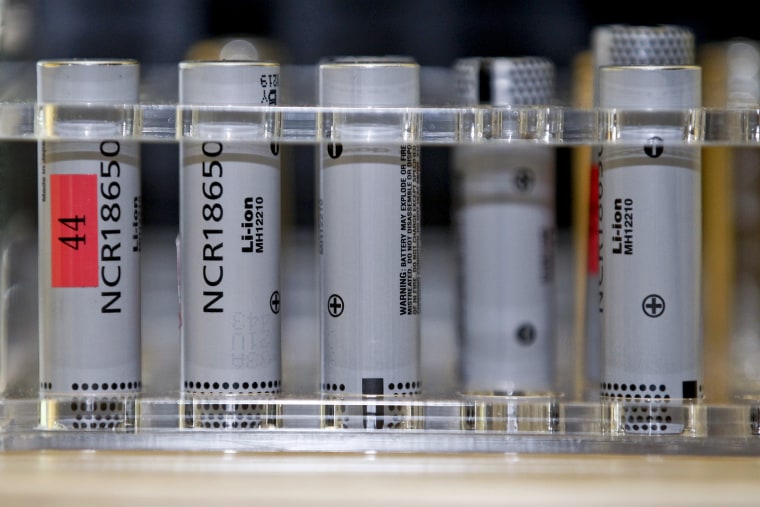In May 2018, Wake D'Elia was at home using an electronic cigarette when the device's battery malfunctioned and exploded, killing him instantly. He was 38.
An investigation revealed that the battery was what's called an 18650.
The explosion caused the device to shoot "like a rocket into the cranial cavity and then [fall] to the ground, igniting a fire at the same time," said Lt. Steven Lawrence, deputy fire marshal for St. Petersburg Fire Rescue.
"It appears the battery failed, and when it failed, it was quick," Lawrence told NBC News.

This was not the first time that an 18650 battery has been implicated in an e-cigarette explosion. Concern over these accidents prompted the Food and Drug Administration recently to take the first steps toward monitoring the devices.
"The incidents that we've seen generally involve ... vaping devices that use the drop-in 18650s," said George Kerchner, executive director of The Rechargeable Battery Association, known as PRBA. "That’s where we have our biggest concern."
An 18650 is slightly larger than a AA battery. They are lithium-ion products that, according to Kerchner, are "robust cells that have a stainless steel can so they can withstand the rigors of outdoor power equipment." Indeed, the batteries' intended use is in electric vehicles and power tools - not devices that consumers can modify and put into their mouths.
The 18650 batteries are often used in certain types of electronic cigarettes called mechanical mods, which are specialized vaping devices that do not have an internal safety circuitry.
"The hallmark of the devices is that the batteries need to be taken out and charged," said Gregory Conley, president of the American Vaping Association.

But simply doing so can put users at risk. That's because the act of taking 18650s in and out of vaping devices or chargers can damage the cell's insulating wrapper, compromising the safety of the battery, Kerchner said.
Mechanical mods give consumers control over the intensity of their vaping experience.
But, Conley said, "if you attempt to draw too much power off those batteries, or if you use a damaged battery, and you have metal-on-metal contact, that's when these incidents occur."
"If you are going to use a mechanical mod ... you need to learn battery safety," Conley added.
Those in the battery industry take the advice a step further.
"We strongly recommend consumers stay away from vaping devices that are powered by 18650s," Kerchner said.
JUUL devices, which resemble small computer flash drives, do not appear to carry this risk. They do have lithium-ion batteries, but they are not 18650s, and they are designed to remain permanently in place.
"The manufacturer of JUUL specifically worked with the battery manufacturer to design a battery. They have overcharge protection," Kerchner said.
"Flaming rockets"
A recent study from George Mason University estimated there were more than 2,000 visits to U.S. emergency rooms from 2015 to 2017 for e-cigarette burns and explosion-related injuries.
The vast majority of those injured were men who had put e-cigarette batteries in their pants or shorts pockets when they said the batteries exploded.
Many experienced severe burns to their legs, arms and hands. Some also had keys in their pocket - a dangerous mix of metal and lithium-ion batteries.
A 2017 report from the U.S. Fire Administration, in charge of fire data collection, education, research and training, stated, "The shape and construction of electronic cigarettes can make them [more likely than other products with lithium-ion batteries] to behave like 'flaming rockets' when a battery fails."
The author of that report, Larry McKenna, said lithium-ion batteries contain two thin plates separated by a sponge saturated with a combustible liquid similar to kerosene in terms of flammability.
"If those two thin plates touch, that liquid then heats up and bursts into flame," said McKenna.
Still, the failure rate is low. "Not many of these [explosions] happen, but because we are holding these things in our pockets or in our mouths or in our hands," said McKenna, "we’re much more intimate with the hazard when it does happen."
Deadly explosions
Two e-cigarette explosions have proven fatal. In addition to D'Elia, a 24-year-old Texas man was killed in January when his e-cigarette exploded, sending a metal part of the device into his neck, severing an artery.
Chris D'Elia, Wake's father, said that when his son's e-cigarette exploded, "the metal part of the pipe was actually embedded in his skull."
"He died instantly. He was dead before he hit the ground," D'Elia told NBC News.
D'Elia remembers his son as a "beloved character" who was a world traveler, an accomplished videographer and a music aficionado.
"People were drawn to him; he was a magnet to others," he said.

Wake D'Elia also worked for CNBC for nine years, until 2015.
"It was horrible," D'Elia said of the accident that killed his son. "Everything was horrible about this."
D'Elia said he made the decision to speak publicly about his son's death to make others aware of the potential for disaster when using vape mods.
"He's gone. I can never get him back. But maybe I can help somebody else so they don't have to go through this agony."
Safety standards
Changes may be coming to the industry. Last October, a global independent safety science company, Underwriters Laboratories, announced the first safety standard for the electrical, heating, battery and charging systems for e-cigarettes.
"One of the key criteria for this standard is that the battery, like the 18650 commonly used in these devices, cannot be removed by the customer," said Michael Sakamoto, senior business development manager at UL.
The group tests the devices in multiple ways. "We drop it, we crush it, we do a number of things to make sure that it holds up to the rigors of use, but also if it does fail, it fails safely," Sakamoto said.
Only a handful of e-cigarette manufacturers qualified to have the UL mark on their packaging, including Joyetech, Eleaf, Innokin, Shenzhen IVPS and Shenzhen Smoore Technology.
Nine devices from these companies received the UL mark. A few, but not all, are sold in the U.S.
"The highest discharge of that battery occurs when you're inhaling. Manufacturers should take this very seriously," Sakamoto told NBC News.
And the Food and Drug Administration recently finalized guidance for manufacturers submitting new applications for tobacco products, which includes e-cigarettes. The agency now recommends that companies provide detailed information about the kinds of batteries they use, as well as plans for addressing the likelihood of overheating, fire and explosion.
Those who advocate for the use of electronic cigarettes to help people quit smoking point out that injuries related to e-cigarette explosions are rare.
"There are hundreds of thousands of people who build their own coils and vape every day and do it without issue," Conley said.
"The public health benefit far outweighs any risk to the public. This technology, in my mind, is going to reduce death and disease in the long run," he told NBC News.
However, Conley stressed that using advanced mechanical mod systems requires consumers to learn battery safety. He said there are ways consumers can reduce their risk of e-cigarette-related battery failure:
- Never use a battery that has been damaged, or exposed to extreme temperatures
- Do not store 18650 batteries in pockets or bags. Always use a protective case, sold in most vape shops, for storage.
- Do not leave batteries on a charger longer than necessary
- Do not get batteries wet
- Move away from the device quickly if you feel it getting abnormally warm
- Do not block ventilation holes on the device
The Consumer Advocates for Smoke Free Alternatives Association also suggests only purchasing high-quality batteries from a known source. Its website states, "Beware of re-branded batteries claiming to have 'high output' – many of these are counterfeit and will fail."
Beyond those safety measures, Conley said anyone using a mechanical mod to vape must be educated about voltage, current and resistance.
"If you are not willing to put in the time to learn how to use that product," advised Conley, "don't use it."
Follow NBC HEALTH on Twitter & Facebook.

